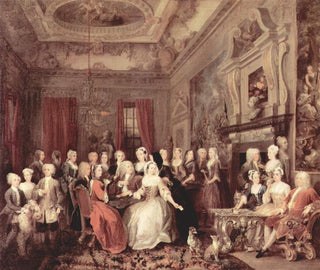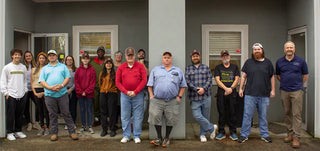OUR MISSION
Honor the rich history of tea.
Oliver Pluff is an all-American company preserving the tradition of time-honored teas and early American coffee blends. The tradition of tea and coffee spans American history in its entirety. Our teas and coffees honor this history through flavors, ingredients, and more.

OUR PROMISE
Sip a Cup of History
A cup of Oliver Pluff tea or coffee is a toast to superior quality of ingredients, and a tribute to the American story. We would love to share a cup of history with you!

Owner and Tea Blender
Darren Hartford
Darren was born and raised in Smithfield, Maine. Darren spent over 28 years in the Air Force where he had the opportunity to travel the world and experience many different tea and coffee cultures. He and his family settled in Charleston and he is enjoying sharing the story of Early American Beverages!
Our Team




Assistant Warehouse Manager
Victoria Velez

Graphic Designer
Brandon Frye

The Warehouse and Production Team
Tea Comes to the Americas
By Kyle Brown, Founder, Oliver Pluff & Company
Published by CRAFT Magazine, Winter 2016, page 144-148.
The spirit of the age was one of conquest of foreign lands for gold and silver, and glory, for the expanding European kingdoms. It is aptly summarized in the cataclysmic story of Cortez:
Cortez sailed in 1511 from Cuba for Mexico with 6 ships and encountered a land so hostile that his crew was unable to disembark, and was forced to sail to Florida for water. When the wells were finally dug, one man drank so much that he instantly died. Cortez then returned and gained a foothold in Mexico, subduing tribe after tribe. He burned his ships to deter any thought of retreat. Defeated tribes joined his army and ushered him forward into a final epic conflict with Montezuma in the city of Mexico, a floating city of flowering houses built on a lake. The Americas were an exotic and tragic place.
This bloody conflict set the stage for the next two centuries in the Americas.
Instead of gold, however, the real wealth of the New World was its botanicals. The Americas’ native crops were potatoes, tomatoes, corn, tobacco, and chocolate.
Imagine Italy with no tomatoes, or France and Belgium with no chocolate. Europe would eagerly receive the newly discovered botanicals from around the globe.
The British seized on the opportunity to trade newly discovered cash crops. Spices were carried from the East, clothing and hardware were carried from Britain, and cotton, sugar, timber, rice, and indigo were carried from the Americas. Thus, the Honourable East India Company was born. Founded by royal charter in the year 1600, the mark of the company became the world’s first registered trademark. Other European nations formed their own East India companies as well, including the Danish, the Dutch, the French, the Swedish, and the Portuguese. But none would trade on the scale of the British. The British East India Company would rise to dominate half of the world’s trade, raising up its own government and military, minting its own money, even holding all of India as a company property.
Yet, tea had not been discovered by the West.
The first written record of tea by English merchants appeared in the year 1615. An East India Company officer in Japan named Richard Wickham wrote a letter to merchants in Macao requesting “a pot of the best sort of chaw”. This “cha”, as it was called, was being harvested from Chinese gardens that were already centuries old. But it would take another 50 years for Britain to take notice of tea.
As a commodity traded in East India Company ships, tea was lightweight, packed easily, and fetched good prices. It was an ideal cargo. Tea became fashionable in upper-class Britain as a luxury of the Far East, and as a relief from the bleak, wet winters. As imports increased, tea became affordable to all classes as a staple of British life. Tea outsold beer.
"There was a thirst for tea in the colonies. In the tumult and chaos of competing New World colonies, tea became a token of civility and culture. [...] It was an age of experimentation and discovery of new fruits and foods and beverages. But none matched the enthusiasm for tea."
Even the most far-flung corners of the British Empire took notice. There was a thirst for tea in the colonies. In the tumult and chaos of competing New World colonies, tea became a token of civility and culture. Coffee and chocolate were also imported and sampled. It was an age of experimentation and discovery of new fruits and foods and beverages. But none matched the enthusiasm for tea. The Honourable East India Company became more commonly known as the East India Tea Company, as most of its cargo was tea.
The Chinese and Japanese preferred to produce and drink green tea only. Black tea was off-loaded to the British, with the unexpected benefit for the British that black tea was more able to withstand the vagaries of a two-year voyage to reach Britain or the American colonies. Tea markets were in Canton, China. The Chinese sold tea to the British from various gardens with tea names such as Hyson, Gunpowder, Singlo, Congou, Souchong, and Bohea.
The most desirable tea leaves are the small green tendrils that grow at the end of the branch in Springtime. Pekoe and Souchong leaves are larger leaves, farther down the branch, and less desirable to the Chinese. These leftover leaves and stems were processed to become a lightly smoky black tea blend known as Bohea tea (pronounced “Boo-hee” - Ukers 510). It would become the most popular import in the colonial Americas, consumed in greater quantities than all other teas combined.
Souchong tea is a large leaf black tea that is smoked over pine. It would one day become Winston Churchill’s favorite tea for its smoky flavor.
Congou is a word that means “quality”. This tea was more skillfully/carefully processed by tea masters.
For the sea journey, tea was packed into wooden chests lined with sheets of pewter, or in small wooden boxes known as tea caddies. Very few of these boxes or crates have survived the centuries. Chinese ceramics became a fashionable export as well, known as “chinoiserie” in the colonies.
"After a century of tea trade, the tea craze in the American colonies and Britain reached such fervor that preachers began to rail against the excesses of tea, encouraging backyard gardens of peppermint as a substitute."
Fast-sailing ships known as East Indiamen were built to shorten the sea voyage. Tea was carried to four American ports in Boston, New York, Philadelphia, and Carolina (Charles Town). The market for tea grew steadily. After a century of tea trade, the tea craze in the American colonies and Britain reached such fervor that preachers began to rail against the excesses of tea, encouraging backyard gardens of peppermint as a substitute.
English and American silversmiths created silver teaware of high quality. Paul Revere, the famous American patriot, was also a skilled silversmith who created numerous silver pieces which survive to this day.
By the late 18th century, the Dutch East India Company outpaced the British in the tea trade to the Americas. With few records for verification, the Dutch traded over 90% of the tea to the Americas, typically smuggled in to avoid tea tax. Smuggled tea was considered “loose tea”.
At the Green Dragon tavern in Boston, coffee, tea, and drinking chocolate were served while men hatched plans for their revolt against the British. The tea tax and the Revolution would reverse America’s interest in tea for a time. Coffee, drinking chocolate, and wild-picked herbs served as substitutes.
Upon independence, America would build her own East Indiamen to continue the tea trade. Tea sales in America continued to increase into the late 19th century, before fading in popularity to coffee in the 20th century.
In modern times, iced tea commands over 95% of total tea sales in America, which makes us distinctive as the only nation that prefers its tea iced. Fueled by Prohibition, iced tea became a cornerstone of Southern life as a sweet, strong staple.
Mixologists are finding inspiration from the colonial era, blending smoky bohea tea syrups with vodka, or serving young hyson green tea as a base for chilled cocktails mixed with rum, lemon juice, and champagne. It’s a fusion of heritage teas served iced and spiked with craft bourbons, rums, or vodkas.
Sip, and ponder the history in each cup, or cold glass, of tea. I ponder the Green Dragon tavern in revolutionary Boston. I ponder the aroma of tea ships and tea warehouses, and the way tea changed the world as we know it today. I ponder landing in the New World and sipping chocolate for the first time. Let’s try that with vodka too.
* * *
Article link: https://www.joomag.com/magazine/craft-by-under-my-host-no-11-the-americas/0235480001476465080?short
